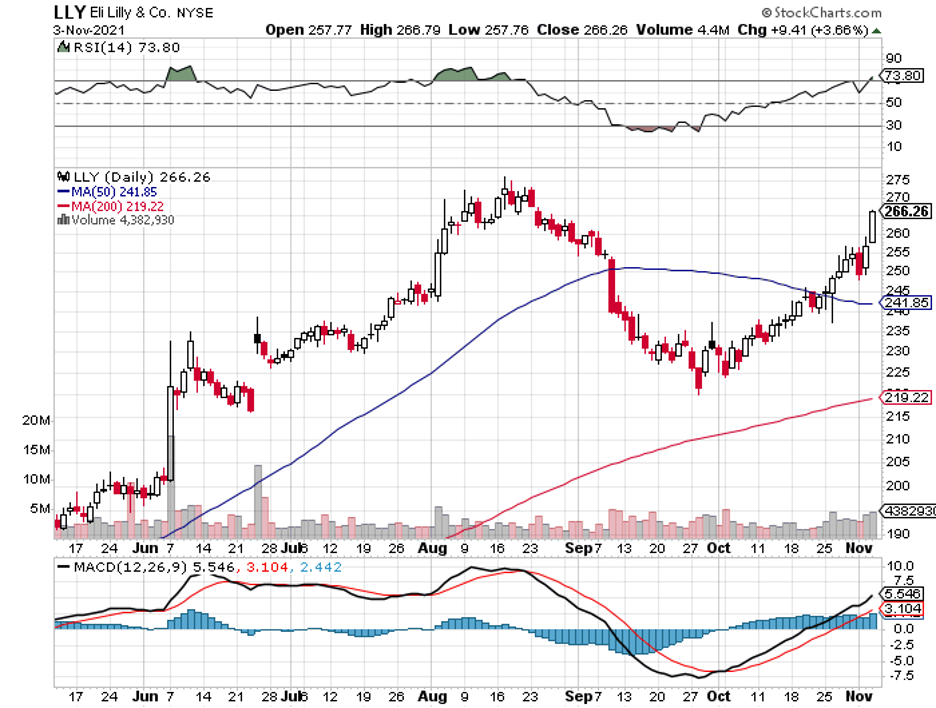Investors can enjoy long-term recurring income and stability with dividend stocks. However, paying out dividends is largely discretionary.
Each business frequently determines whether it’s in a good position to hand out part of its profits to shareholders.
One method to assess a dividend’s safety is reviewing a company’s history and whether it makes regular payouts. The longer its track record shows a consistent payment, the more preferable the business.
There’s a stock particularly known for paying dividends every year for over a century in the biotechnology and healthcare sector: Eli Lilly (LLY).
While Eli Lilly’s dividend yield is only 1.5% at its current share price, which is a bit over the S&P 500’s average reported at less than 1.3%, the company has been paying out dividends since 1885.
Apart from its consistent payouts throughout the years, Eli Lilly also holds promising potential for future hikes.
At the moment, the quarterly payout of Eli Lilly is $0.85, which is 75% higher than its 2015 payout of $0.49.
This number can still climb thanks to its robust revenue growth of 19.2% year over year, with its current approved drug portfolio generating $13.55 billion in the first six months of 2021.
In the first two quarters of the year alone, several products recorded year-over-year sales growth of over 20%.
Eli Lilly isn’t content in growing its dividend, though. It’s also working on expanding its drug portfolio.
Among its existing drugs, the company has been maximizing Olumiant to include more indications.
One of the recent advancements involving Olumiant is Eli Lilly’s work with Incyte (INCY), which utilizes the drug as a treatment for COVID-19 patients.
In fact, the FDA has recently approved the use of Olumiant with or without the need to combine it with Gilead Sciences (GILD) Remdesivir.
However, Olumiant’s application as a COVID-19 treatment isn’t the most promising expansion for this drug.
Just recently, Eli Lilly and Incyte disclosed that Olumiant could be used as a treatment for an autoimmune disorder more commonly known as alopecia areata—an indication that could very well transform the drug into the company’s next blockbuster.
In a nutshell, Olumiant can help alopecia patients regrow their hair at a more rapid speed and consistent rate than other competitors.
So far, the drug has recorded an 80% hair growth among those who tested it.
In the previous months, the FDA included Olumiant and AbbVie’s (ABBV) Rinvoq in the list of JAK inhibitors that needed to carry a warning label sharing their severe potential side effects like blood clots and even cancer.
Despite this, Eli Lilly’s product proved to be safe for alopecia patients.
If approved for alopecia, Olumiant could become a groundbreaking treatment sought after by roughly 147 million people across the globe who suffer from the condition.
For context, the global market for alopecia is projected to grow in revenue from $ 7.6 billion in 2020 to reach over $ 14.2 billion by 2028 annually.
Alopecia areata, which is the target market of Eli Lilly, is expected to hold about 35% of the total. This puts the addressable market for Olumiant at $5 billion by 2028.
Considering that another name has been working to dominate the market, Pfizer’s (PFE) Cibingo, we can realistically assume that Eli Lilly will get at least 15% of the market share worldwide.
This would mean roughly $750 million in yearly revenue for Olumiant’s alopecia market alone.
Other than its work on alopecia areata, Eli Lilly has another potential blockbuster. This time, the treatment is targeting the diabetes sector.
The company has an up-and-coming treatment called Tirzepatide, which could not only expand Eli Lilly’s diabetes market share but also provide a strong competitor against Novo Nordisk’s (NVO) top-selling Ozempic.
Tirzepatide is the successor of Eli Lilly’s bestseller Trulicity, which logged $2.99 billion in the first half of 2021 and is set to lose patent protection by 2027.
Looking at Tirzepatide’s trajectory, the drug is projected to reach peak annual sales worth $10 billion—an amount that could easily offset the gradual decline in sales by Trulicity.
Even the company’s breast cancer drug, Verzenio, is set to show off impressive growth soon. In the first half of 2021, the treatment raked in $610 million in sales, demonstrating a 53.8% increase year-over-year.
Considering Eli Lilly’s efforts to distinguish its breast cancer treatment from Pfizer’s Ibrance, Verzenio is anticipated to generate $4.6 billion in annual sales by 2024.
Another exciting development is Eli Lilly’s Alzheimer’s disease treatment Donanemab.
Although Phase 3 data are expected to be released in 2023, this candidate is already reported to be a superior treatment than Biogen’s (BIIB) controversial Aduhelm.
These are some of the results of Eli Lilly’s efforts to continue expanding in the diabetes area, as seen in its ramped-up R&D spending.
So far, the company boosted its research investment by 21% year-over-year to reach $3.36 billion.
While doing this isn’t exactly a guarantee of commercial success, it’s undoubtedly a solid strategy to protect and enhance its pipeline.
Overall, Eli Lilly is a high-quality stock with a verifiable and impressive history of innovation.
Given the promising lineup of approved drugs and pipeline candidates of Eli Lilly, it’s reasonable to expect roughly a 15% yearly earnings growth from the company over the next 5 years.

